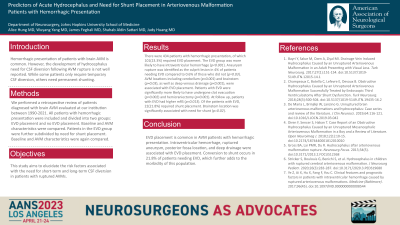Predictors of Acute Hydrocephalus and Need for Shunt Placement in Arteriovenous Malformation Patients with Hemorrhagic Presentation
Friday, April 21, 2023


Wuyang Yang (he/him/his)
Chief Resident (PGY6)
Johns Hopkins University School of Medicine
Baltimore, Maryland, United States
ePoster Presenter(s)
Introduction: Hemorrhagic presentation of patients with brain arteriovenous malformation (AVM) is common. However, the need for CSF diversion following AVM rupture is not well reported. This study aims to elucidate the risk factors associated with the need for short-term and long-term CSF diversion in patients with ruptured AVMs.
Methods: We performed a retrospective review of patients diagnosed with brain AVM evaluated at our institution between 1990-2021. All patients with hemorrhagic presentation were included and divided into two groups: EVD placement and no EVD placement. Baseline and AVM characteristics were compared. Patients in the EVD group were further subdivided by need for shunt placement. Baseline and AVM characteristics were again compared.
Results: There were 434 patients with hemorrhagic presentation, of which 101(23.3%) required EVD placement. The EVD group was more likely to have intraventricular hemorrhage (p < 0.001). Aneurysm rupture was identified as the culprit lesion in 4% of patients needing EVD compared to 0.6% of those who did not (p=0.03). AVM locations including cerebellum (p < 0.001) and brainstem (p=0.03), as well as deep venous drainage (p < 0.001), were associated with EVD placement. Patients with EVD were significantly more likely to have undergone clot evacuation (p=0.002) and hemicraniectomy (p < 0.001). At follow up, patients with EVD had higher mRS (p=0.013). Of the patients with EVD, 22(21.8%) required shunt placement. Brainstem location was significantly associated with need for shunt (p=0.02).
Conclusion : EVD placement is common in AVM patients with hemorrhagic presentation. Intraventricular hemorrhage, ruptured aneurysm, posterior fossa location, and deep drainage were associated with EVD placement. Conversion to shunt occurs in 21.8% of patients needing EVD, which further adds to the morbidity of this population.
Methods: We performed a retrospective review of patients diagnosed with brain AVM evaluated at our institution between 1990-2021. All patients with hemorrhagic presentation were included and divided into two groups: EVD placement and no EVD placement. Baseline and AVM characteristics were compared. Patients in the EVD group were further subdivided by need for shunt placement. Baseline and AVM characteristics were again compared.
Results: There were 434 patients with hemorrhagic presentation, of which 101(23.3%) required EVD placement. The EVD group was more likely to have intraventricular hemorrhage (p < 0.001). Aneurysm rupture was identified as the culprit lesion in 4% of patients needing EVD compared to 0.6% of those who did not (p=0.03). AVM locations including cerebellum (p < 0.001) and brainstem (p=0.03), as well as deep venous drainage (p < 0.001), were associated with EVD placement. Patients with EVD were significantly more likely to have undergone clot evacuation (p=0.002) and hemicraniectomy (p < 0.001). At follow up, patients with EVD had higher mRS (p=0.013). Of the patients with EVD, 22(21.8%) required shunt placement. Brainstem location was significantly associated with need for shunt (p=0.02).
Conclusion : EVD placement is common in AVM patients with hemorrhagic presentation. Intraventricular hemorrhage, ruptured aneurysm, posterior fossa location, and deep drainage were associated with EVD placement. Conversion to shunt occurs in 21.8% of patients needing EVD, which further adds to the morbidity of this population.
